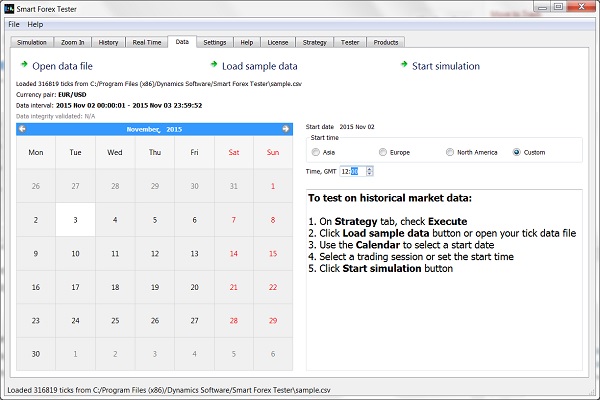Offline Forex Simulator is a software tool that fully imitates the markets on our demand – whenever we want it, and even without a connection to Internet.
Offline Simulator is very handy for most of us who have our day job. Watching Forex markets requires time, which is not easy to find during busy weekdays. The Simulator helps to do that during weekends.
How does the Simulator work? It “plays back” saved market data. Similar to watching a video tape – if by video tape we mean a file of price quotes.
A good Offline Forex Simulator provides 100% accurate market modelling quality. For that it must support tick-by-tick data. A “tick” is a new price quote received by the market. For any currency pair, a tick is a combination of 3 numbers: bid price, ask price and time stamp.
The time stamp has an accuracy of up to 1 ms. Such high precision is not excessive.
There can be over ten ticks each second during fast market moves. Which often happen during some events or major news releases. However, ticks can also come as rarely as 1 in a minute, typically in slow Asian sessions.
In this article we will show you step-by-step how you can test your trading strategy with the help of our Offline Forex Simulator.
First of all, you need to download and install the software. It is free for our subscribers. If you haven’t yet subscribed, do it here.
Once you activated your free Forex Simulator license, navigate to the Data tab. This is where you select and load the tick files. The Simulator provides an inbuilt data file for you to try out of the box. The file contains 2 days worth of ticks, which is more than enough to get you started.
We will use the inbuilt file in our example.
Once you have loaded the file, the offline Simulator shows the loaded data interval on a monthly calendar. This doesn’t mean that only 1 month long files are supported. The calendar just shows the 1st month of the data for you to select the start date and time for testing.

You have the options to specify the exact time, or select one of the standard times, corresponding to the start of 3 major trading sessions (USA, Europe and Asia).
Let’s select the time known for the most intensive trading – when the US and European trading sessions start to overlap (at noon GMT) and begin a new simulation with pressing the Start button.